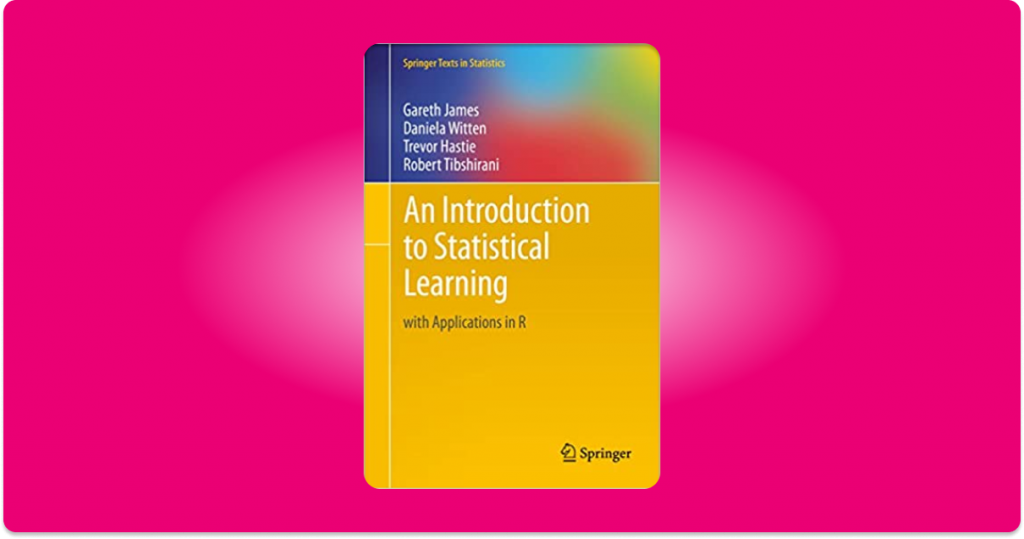Understand how to make sense of data with this amazing introduction to statistical learning!

Looking for a guide to the world statistical learning? The following is a review of the book An Introduction to Statistical Learning: with Applications in R (Springer Texts in Statistics) by Gareth James, Daniela Witten, Trevor Hastie and Robert Tibshirani, a book that accomplishes just that.
Review of an Introduction to Statistical Learning
Data and statistics are an increasingly important part of modern life, and nearly everyone would be better off with a deeper understanding of the tools that help explain our world. Even if you don’t want to become a data analyst, Machine learning engineer, or Data Scientist―which happen to be some of the fastest-growing jobs out there―this book is an invaluable guide to help explain what’s going on.
An Introduction to Statistical Learning provides an accessible overview of the field of statistical learning, an essential toolset for making sense of the vast and complex data sets that have emerged in fields ranging from biology to finance to marketing to astrophysics in the past twenty years.
It presents the perfect introduction to the intersection between statistics and machine learning, covering topics that go from the most basic like linear regression to more advanced like Support Vector Machines and clustering techniques. Its contents provide a great se of tools for data analysis and predictions, including the most common Machine Learning algorithms except Artificial Neural Networks: Regressions, Logistic Regression, Linear discriminant analysis, Decision Trees, Random Forest, Boosting, Cross Validation, SVM, PCA, K-means clustering and more.
As the goal of the book, aside from teaching the main concepts behind these techniques is to present them in a practical and applicable manner, each chapter contains a tutorial on implementing the analysis methods and prediction techniques in the R programming language. While in this blog we normally recommend Python as the de-facto programming language for Data Science, R offers some great analysis tools and statistical methods that are hard to find with any other language/framework.
Also, at the end of each chapter there are exercises that cover both, the theoretical and practical parts of what has been covered, and that are a perfect (and sometimes challenging) way to test our working knowledge of what has been taught up to that point. We profoundly recommend dedicating some time to slowly and properly completing these exercises.
Overall, the book offers a clear application of the Mathematics and application of the R programming language to statistical learning, with fantastically written, beautiful explanations of each topic, that requiere a solid mathematical background. Later in this article, we will cover in depth who this book is oriented to.
Two of the authors of An Introduction to Statistical Learning, are authors of the famous text The Elements of Statistical Learning (The Bible of Machine Learning). Because of the more advanced character of that book, many people think that An Introduction to Statistical Learning is a good precursor for the former book, however, from our point of view this is not true. Both books cover similar topics, however, An Introduction to Statistical Learning does so in a much more accesible manner, making the book great fro a much broader audience. For people with a very high level of math then The Elements of Statistical Learning might be the preferred way to dig deeper into some topics, but for those that do not have a great mathematical background then An Introduction to statistical learning is probably a better option.
If you are not a mathematician or have a Bachelor or PHD in Mathematics, and you just need to apply data analytics to your research or in your job, this book will really help you.
Contents of an Introduction to Statistical Learning
The contents of the book are the following:
- Introduction: an overview and brief history of statistical learning, a vast set of tools for understanding data, and some examples.
- Statistical Learning: what is statistical learning, inference, parametric and non-parametric methods, and the trade-off between accuracy and model interpretability. Bias-variance trade-off and a lot more!
- Linear Regression: this chapter explains the most simple approach to supervised learning, how to estimate the coefficients, the different errors, and all you need to know.
- Classification: approaches to calculate discrete target variables and the detail of logistic regression, Linear Discriminant Analysis, and Bayes Theorem.
- Resampling Methods: how to draw examples from a training set and refitting a model of interest in each example in order to obtain additional information about the fitted model.
- Linear Model Selection and Regularization: chapter 6 introduces approaches for extending the framework of linear models to GLM, and how to avoid model variance: Lasso and Ridge Regression.
- Moving Beyond Linearity: going beyond linear models to polynomial regression, smoothing splines, generalised additive models and more!
- Tree-Based Methods: decision trees for classification and regression, bagging and random forest.
- Support Vector Machines: this chapter explains maximum margin classifiers and their evolution to Support Vector Machines. How they are trained, used to make predictions and their advantages and disadvantages.
- Unsupervised Learning: we end with clustering and dimensionality reduction, k-means, hierarchical clustering and Principal Component Analysis.
On the following link you can find the official Springer website of the text.
Also, most of the contents covered in this book can be found on Youtube on the StatLearning video series by the same authors. On the following video you can find the first lesson, with an Introduction of statistical learning, how it has evolved, and its relationship with Machine Learning.
Who is this book for?
In general, this book is oriented to those who wish to use cutting-edge statistical learning techniques to analyse and leverage the power of their data, requiring only the maths that can be provided by any STEM university degree. If you have that math background cover, then this text is a great Introduction to statistical learning.
We think this book is best for those with a Computer Science background, that are already implementing Machine Learning algorithms and models, that want to step up their understanding of the underlying theory behind them. It is a great continuation of many introductory Machine Learning courses, as it will allow you to deepen your knowledge and consolidate what you already have learned.
Many people want to go into the field of Machine Learning in a very fast paced manner, by learning straight away how to code and implement algorithms. For use, while it migth be good to start by programming to asses if you like it and are interested in further learning, it is also essential that once this has been covered you obtain a strong statistical base, which this book is perfect for.
Summary of an Introduction to Statistical Learning
An Introduction to Statistical Learning is great book to learn the basis of Machine Learning, if picked up by the right audience. If you are looking to obtain a profound statistical knowledge of the concepts underlying machine learning algorithms, but don’t want to go into a supe heavy mathematical text like The Elements of Statistical Learning, then this book is an awesome candidate. It will give you a very strong foundation and a great understanding of the statistics of Machine Learning, and a great idea of how to implement the algorithms using R.
It is one of the best Machine Learning books to start going deep into the theory, and is also great to for those in the business of mathematics and statistics.
Level up on your Data Skills with ‘An Introduction to Statistical Knowledge’! You can find the book on amazon at the best price here:
- This book presents some of the most important modeling and prediction techniques, along with relevant applications
- Topics include linear regression, classification, re-sampling methods, shrinkage approaches, tree-based methods, support vector machines, clustering, and more. Color graphics and real-world examples are used to illustrate the methods presented.
- Since the goal of this textbook is to facilitate the use of these statistical learning techniques by practitioners in science, industry, and other fields, each chapter contains a tutorial on implementing the analyses and methods presented in R, an extremely popular open source statistical software platform
- Hardcover Book
- James, Gareth (Author)
In case you want books that cover Python, check out our full Machine Learning books category.
Also, there are a couple of great starting book and courses that we always recommend, check them out!
Book reviews:
- The 100 page Machine Learning Book
- Hands-On Machine Learning with Scikit-Learn & Tensorflow.
- Deep Learning with Python by Francois Chollet.
Courses
- Coursera: Machine Learning by Andrew Ng
- Complexity Explorer: Fundamentals of Machine Learning
- Udemy: Python for Data Science and Machine Learning Bootcamp.
As always, thank you for reading How to Learn Machine learning! We hope that you liked the review, please feel free to drop us a comment and follow us on Twitter!. Have a great day!

Subscribe to our awesome newsletter to get the best content on your journey to learn Machine Learning, including some exclusive free goodies!

